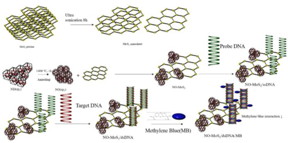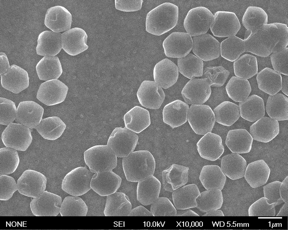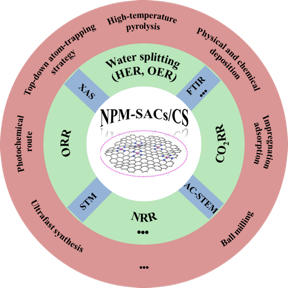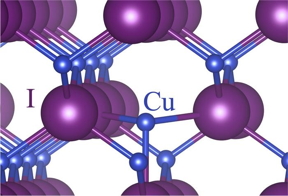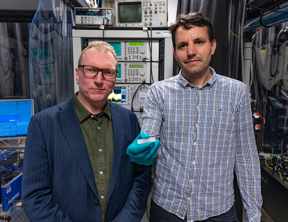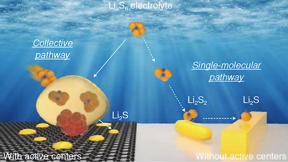Home > Press > Chung-Ang University researchers develop novel DNA biosensor for early diagnosis of cervical cancer: The electrochemical sensor, made of a graphitic nano-onion/molybdenum disulfide nanosheet composite, detects human papillomavirus (HPV)-16 and HPV-18, with high specificity
 |
| Chung-Ang University researchers have developed a novel electrochemical nano-onion/molybdenum disulfide nanosheet composite-based DNA biosensor that efficiently and specifically detects human papillomavirus (HPV)-16 and HPV-18, enabling early diagnosis of cervical cancer. CREDIT Journal of Nanobiotechnology |
Abstract:
Molybdenum disulfide (MoS2) has recently garnered attention among materials science researchers owing to its ability to form two-dimensional nanosheets like graphene. The nanosheets are created by the stacking of S–Mo–S layers interacting via Van der Waals interactions. Additionally, the unique structural, optical, thermal, and electrochemical properties of MoS2 have opened up multiple research avenues across several fields, including the development of biomolecule sensing and chemical detection platforms, optoelectronics, supercapacitors, and batteries.
Chung-Ang University researchers develop novel DNA biosensor for early diagnosis of cervical cancer: The electrochemical sensor, made of a graphitic nano-onion/molybdenum disulfide nanosheet composite, detects human papillomavirus (HPV)-16 and HPV-18, with high specificity
Seoul, Republic of Korea | Posted on September 8th, 2023
Traditionally, carbon nanostructures have been employed as an immobilization platform for DNA. In order to substitute carbon with MoS2 as an effective electrochemical DNA sensor, the electrical conductivity of MoS2 needs to be improved considerably. Against this backdrop, Associate Professor Eunah Kang and Mr. Youngjun Kim from the School of Chemical Engineering and Material Science at Chung-Ang University, Korea have recently come up with an elegant solution. The duo has developed an electrochemical DNA biosensor using a graphitic nano-onion/molybdenum disulfide (MoS2) nanosheet composite, which effectively detects human papillomavirus (HPV)-16 and HPV-18, and can serve as an early diagnosis of cervical cancer.
“Nano-onions possess graphitic sp2 structures and are derived from crystalline sp3 nanodiamonds via thermal annealing or laser irradiation,” explains Dr. Kang. Their breakthrough was published in Volume 21 of the Journal of Nanobiotechnology on 10 June 2023.
The researcher duo prepared the novel electrode surface for probing DNA chemisorption by enabling chemical conjugation between two functional groups: acyl bonds on the surfaces of functionalized nano-onions and amine groups present on the modified MoS2 nanosheets. Cyclic voltammetry experiments revealed that a 1:1 composite electrode had an improved rectangular shape compared to that of an MoS2 nanosheet electrode. “This indicated the amorphous nature of the nano-onions with curved carbon layers that facilitated an enhancement in electronic conductivity compared to MoS2 nanosheet alone,” highlights Dr. Kang.
Additionally, the duo measured the sensitivity of their novel electrochemical DNA biosensor device towards HPV-16 and HPV-18 by employing differential pulse voltammetry (DPV) technique in the presence of methylene blue (MB) as a redox indicator. Dr. Kang elaborates: “The DPV current peak was lowered after probe DNA chemisorption and target DNA hybridization. Since the hybridized DNA was double-stranded, it induced less effective MB electrostatic intercalation, resulting in a lower oxidation peak.”
The duo found that, compared to the MoS2 nanosheet electrode, the nano-onion/MoS2 nanosheet composite electrode attained higher current peaks, indicating a greater change in the differential peak. This was attributed to an enhanced conductive electron transfer owing to the nano-onion.
Notably, the target DNAs produced from HPV-16 and HPV-18 Siha and Hela cancer cell lines were detected by the proposed sensor effectively and with high specificity. Consequently, MoS2 nanosheets with improved electrical conductivity facilitated by complexation with nano-onions provides a suitable platform for developing effective and efficient electrochemical biosensors for the early diagnosis of a wide variety of ailments, including cervical cancer.
Furthermore, combining nano-onions or nanodiamonds with different organic biomaterials can facilitate chemical functionality, electron transfer conductivity, light absorption, and more. These, in turn, can lead to innovative disease sensing, targeted drug delivery systems, and biomedical imaging and diagnostics.
####
About Chung-Ang University
Chung-Ang University is a private comprehensive research university located in Seoul, South Korea. It was started as a kindergarten in 1916 and attained university status in 1953. It is fully accredited by the Ministry of Education of Korea. Chung-Ang University conducts research activities under the slogan of “Justice and Truth.” Its new vision for completing 100 years is “The Global Creative Leader.” Chung-Ang University offers undergraduate, postgraduate, and doctoral programs, which encompass a law school, management program, and medical school; it has 16 undergraduate and graduate schools each. Chung-Ang University’s culture and arts programs are considered the best in Korea.
Website: https://neweng.cau.ac.kr/index.do
About the author
Eunah Kang is an Associate Professor at the School of Chemical Engineering and Material Science at Chung-Ang University (CAU). She received her Ph.D. in Biomedical Engineering from Purdue University in 2007. Her group at CAU develops versatile approaches to drug delivery systems, sensors, and imaging theragnostic agents by designing complexes with new organic and inorganic materials. This includes combining nanodiamonds or nano-onions with common biopolymers and drug delivery carriers to enable innovative functions and applications in biomedicine.
For more information, please click here
Contacts:
Se-Jin Oh
Chung-Ang University
Office: 02-820-6614
Copyright © Chung-Ang University
If you have a comment, please Contact us.
Issuers of news releases, not 7th Wave, Inc. or Nanotechnology Now, are solely responsible for the accuracy of the content.
| Related Links |
| Related News Press |
Cancer
![]() New compound unleashes the immune system on metastases September 8th, 2023
New compound unleashes the immune system on metastases September 8th, 2023
News and information
![]() New compound unleashes the immune system on metastases September 8th, 2023
New compound unleashes the immune system on metastases September 8th, 2023
![]() Machine learning contributes to better quantum error correction September 8th, 2023
Machine learning contributes to better quantum error correction September 8th, 2023
![]() Tests find no free-standing nanotubes released from tire tread wear September 8th, 2023
Tests find no free-standing nanotubes released from tire tread wear September 8th, 2023
![]() Quantum powers researchers to see the unseen September 8th, 2023
Quantum powers researchers to see the unseen September 8th, 2023
Possible Futures
![]() New compound unleashes the immune system on metastases September 8th, 2023
New compound unleashes the immune system on metastases September 8th, 2023
![]() Machine learning contributes to better quantum error correction September 8th, 2023
Machine learning contributes to better quantum error correction September 8th, 2023
![]() Tests find no free-standing nanotubes released from tire tread wear September 8th, 2023
Tests find no free-standing nanotubes released from tire tread wear September 8th, 2023
![]() Quantum powers researchers to see the unseen September 8th, 2023
Quantum powers researchers to see the unseen September 8th, 2023
Nanomedicine
![]() Electronic detection of DNA nanoballs enables simple pathogen detection Peer-Reviewed Publication September 8th, 2023
Electronic detection of DNA nanoballs enables simple pathogen detection Peer-Reviewed Publication September 8th, 2023
![]() New compound unleashes the immune system on metastases September 8th, 2023
New compound unleashes the immune system on metastases September 8th, 2023
![]() Tattoo technique transfers gold nanopatterns onto live cells August 11th, 2023
Tattoo technique transfers gold nanopatterns onto live cells August 11th, 2023
![]() Detection of bacteria and viruses with fluorescent nanotubes July 21st, 2023
Detection of bacteria and viruses with fluorescent nanotubes July 21st, 2023
Optical computing/Photonic computing
![]() University of Chicago scientists invent smallest known way to guide light: 2D optical waveguides could point way to new technology August 11th, 2023
University of Chicago scientists invent smallest known way to guide light: 2D optical waveguides could point way to new technology August 11th, 2023
![]() USTC enhances fluorescence brightness of single silicon carbide spin color centers June 9th, 2023
USTC enhances fluorescence brightness of single silicon carbide spin color centers June 9th, 2023
Discoveries
![]() Electronic detection of DNA nanoballs enables simple pathogen detection Peer-Reviewed Publication September 8th, 2023
Electronic detection of DNA nanoballs enables simple pathogen detection Peer-Reviewed Publication September 8th, 2023
![]() Training quantum computers: physicists win prestigious IBM Award September 8th, 2023
Training quantum computers: physicists win prestigious IBM Award September 8th, 2023
![]() Tests find no free-standing nanotubes released from tire tread wear September 8th, 2023
Tests find no free-standing nanotubes released from tire tread wear September 8th, 2023
Announcements
![]() Electronic detection of DNA nanoballs enables simple pathogen detection Peer-Reviewed Publication September 8th, 2023
Electronic detection of DNA nanoballs enables simple pathogen detection Peer-Reviewed Publication September 8th, 2023
![]() Training quantum computers: physicists win prestigious IBM Award September 8th, 2023
Training quantum computers: physicists win prestigious IBM Award September 8th, 2023
![]() Machine learning contributes to better quantum error correction September 8th, 2023
Machine learning contributes to better quantum error correction September 8th, 2023
![]() Tests find no free-standing nanotubes released from tire tread wear September 8th, 2023
Tests find no free-standing nanotubes released from tire tread wear September 8th, 2023
Interviews/Book Reviews/Essays/Reports/Podcasts/Journals/White papers/Posters
![]() Electronic detection of DNA nanoballs enables simple pathogen detection Peer-Reviewed Publication September 8th, 2023
Electronic detection of DNA nanoballs enables simple pathogen detection Peer-Reviewed Publication September 8th, 2023
![]() New compound unleashes the immune system on metastases September 8th, 2023
New compound unleashes the immune system on metastases September 8th, 2023
Battery Technology/Capacitors/Generators/Piezoelectrics/Thermoelectrics/Energy storage
![]() Chloride ions from seawater eyed as possible lithium replacement in batteries of the future August 11th, 2023
Chloride ions from seawater eyed as possible lithium replacement in batteries of the future August 11th, 2023
![]() Graphene-based Carbocatalysts: Synthesis, Properties, and Applications—Beyond Boundaries June 9th, 2023
Graphene-based Carbocatalysts: Synthesis, Properties, and Applications—Beyond Boundaries June 9th, 2023
![]() Channeling mechanical energy in a preferred direction April 14th, 2023
Channeling mechanical energy in a preferred direction April 14th, 2023
Nanobiotechnology
![]() Electronic detection of DNA nanoballs enables simple pathogen detection Peer-Reviewed Publication September 8th, 2023
Electronic detection of DNA nanoballs enables simple pathogen detection Peer-Reviewed Publication September 8th, 2023
![]() New compound unleashes the immune system on metastases September 8th, 2023
New compound unleashes the immune system on metastases September 8th, 2023
![]() Tattoo technique transfers gold nanopatterns onto live cells August 11th, 2023
Tattoo technique transfers gold nanopatterns onto live cells August 11th, 2023
Photonics/Optics/Lasers
![]() University of Chicago scientists invent smallest known way to guide light: 2D optical waveguides could point way to new technology August 11th, 2023
University of Chicago scientists invent smallest known way to guide light: 2D optical waveguides could point way to new technology August 11th, 2023
![]() Ultrafast lasers for materials processing August 11th, 2023
Ultrafast lasers for materials processing August 11th, 2023
![]() Femtosecond laser technique births “dancing microrobots”: USTC’s breakthrough in multi-material microfabrication August 11th, 2023
Femtosecond laser technique births “dancing microrobots”: USTC’s breakthrough in multi-material microfabrication August 11th, 2023
- SEO Powered Content & PR Distribution. Get Amplified Today.
- PlatoData.Network Vertical Generative Ai. Empower Yourself. Access Here.
- PlatoAiStream. Web3 Intelligence. Knowledge Amplified. Access Here.
- PlatoESG. Automotive / EVs, Carbon, CleanTech, Energy, Environment, Solar, Waste Management. Access Here.
- PlatoHealth. Biotech and Clinical Trials Intelligence. Access Here.
- ChartPrime. Elevate your Trading Game with ChartPrime. Access Here.
- BlockOffsets. Modernizing Environmental Offset Ownership. Access Here.
- Source: http://www.nanotech-now.com/news.cgi?story_id=57390
- :has
- :is
- :not
- $UP
- 1
- 10
- 100
- 12th
- 16
- 2023
- 21st
- 28
- 2D
- 30th
- 7th
- 8th
- 9th
- a
- ability
- AC
- access
- accredited
- accuracy
- across
- activities
- Additionally
- After
- against
- agents
- alone
- among
- an
- and
- Announces
- Application
- applications
- approaches
- April
- ARE
- Arts
- AS
- Associate
- At
- attained
- attention
- AUGUST
- avenues
- backdrop
- Bacteria
- batteries
- BE
- been
- BEST
- Better
- between
- Biomaterials
- biomedical
- Blue
- Bonds
- breakthrough
- BRIDGE
- by
- CAN
- Cancer
- carbon
- carriers
- cell
- Center
- CGI
- change
- chemical
- chicago
- chip
- click
- color
- COM
- combining
- come
- comment
- Common
- compared
- completing
- complex
- Compound
- comprehensive
- computers
- conductivity
- conducts
- Consequently
- considered
- content
- contributes
- Cost
- could
- created
- Creative
- credit
- Culture
- Current
- Dancing
- Decline
- delivery
- Derived
- designing
- detected
- Detection
- develop
- developed
- developing
- Development
- develops
- device
- diagnosis
- different
- dimensions
- discover
- discovered
- Disease
- dna
- do
- dr
- drug
- Drug Delivery
- each
- Early
- Edge
- Education
- Effective
- effectively
- efficient
- efficiently
- Electronic
- employed
- enable
- enables
- enabling
- encompass
- end
- energy
- Engineering
- enhanced
- enhancement
- Enhances
- error
- Ether (ETH)
- experiments
- Explain
- Explains
- explore
- facilitate
- facilitated
- Fields
- Find
- For
- form
- found
- from
- fully
- functional
- functionality
- functions
- generation
- gif
- Global
- Gold
- graduate
- Graphene
- greater
- Group
- Group’s
- guide
- had
- Harnessing
- Have
- help
- her
- High
- higher
- highlights
- http
- HTTPS
- human
- IBM
- if
- Imaging
- immune
- Immune system
- improved
- in
- Inc.
- includes
- Including
- indicated
- indicating
- Indicator
- information
- innovative
- interacting
- interaction
- interactions
- IT
- ITS
- journal
- July
- june
- Kim
- known
- korea
- laser
- lasers
- launch
- Law
- layers
- lead
- leader
- learning
- less
- Life
- light
- like
- lines
- links
- lithium
- live
- located
- Long
- Low
- lower
- lowered
- made
- management
- many
- material
- materials
- May..
- measured
- mechanical
- mechanism
- medical
- ministry
- modified
- more
- motion
- mr
- multiple
- nanotechnology
- Natural
- Nature
- nearly
- needs
- net
- New
- newly
- news
- no
- Noise
- novel
- now
- NSF
- of
- Offers
- on
- open
- opened
- or
- order
- organic
- pathway
- Peak
- peer-reviewed
- performance
- PHP
- platform
- Platforms
- plato
- Plato Data Intelligence
- PlatoData
- please
- Point
- possess
- possible
- Post
- posted
- postgraduate
- potential
- powers
- preferred
- prepared
- presence
- present
- press
- Press Release
- prestigious
- private
- probe
- Produced
- Professor
- Program
- Programs
- properties
- proposed
- provides
- published
- Publishing
- pulse
- Quantum
- quantum computers
- quantum information
- random
- rapid
- rapidly
- reaction
- received
- receives
- recently
- release
- released
- Releases
- replacement
- Republic
- research
- researcher
- researchers
- responsible
- resulting
- Results
- return
- Revealed
- s
- Save
- scalable
- School
- Schools
- Science
- scientists
- Search
- Sectors
- see
- Semiconductors
- Sensitivity
- sensors
- Seoul
- September
- serve
- several
- Shape
- Share
- she
- Silicon
- silicon carbide
- Simple
- since
- single
- solely
- solid
- solution
- South
- South Korea
- specifically
- specificity
- Spin
- stacking
- start
- started
- States
- Status
- structural
- structures
- submit
- suitable
- Surface
- synthetic
- system
- Systems
- Target
- targeted
- Technologies
- that
- The
- their
- thermal
- These
- this
- tire
- to
- toward
- towards
- transfer
- transfers
- truth
- TURN
- two
- under
- understanding
- unique
- university
- unknown
- unleashes
- unwanted
- us
- used
- using
- USTC
- variety
- versatile
- via
- viruses
- vision
- Voltage
- volume
- was
- Wave
- Way..
- were
- which
- wide
- win
- with
- Yahoo
- years
- you
- zephyrnet

